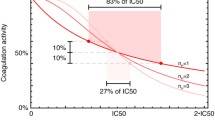Summary
Cardiovascular drugs, as a class, have low therapeutic indices, but also have great therapeutic potential. Plasma concentration information is therefore often of value when using these drugs. Unfortunately, the total plasma concentration may not reflect the concentration of pharmacologically active free drug, since a number of factors including disease states, heparin anticoagulation, non-linear binding characteristics, and in vitro artefacts can affect the protein binding of these agents. This may also explain their poor dose-response relationships and great interindividual variability in plasma concentration data. Careful studies relating bound and free drug concentration to pharmacological response may provide the clinician with a better guide to therapy, and enhance the usefulness of these drugs.
Similar content being viewed by others
References
Borgå, O.; Piafsky, K.M. and Nilson, O.G.: Plasma protein binding of basic drugs. 1. Selective displacement from alpha1-acid glycoprotein by tris (2-butoxyethyl)phosphate. Clinical Pharmacology and Therapeutics 22: 539–544 (1977).
Brown, J.E.; Kitchell, B.B.; Bjornsson, T.D. and Shand, D.G.: the artifactual nature of heparin-induced drug protein-binding alterations. Clinical Pharmacology and Therapeutics 30: 636–643 (1981).
Carliner, N.H.; Fisher, M.L.; Crouthamel, W.G.; Narang, P.K. and Plotnick, G.D.: Relation of ventricular premature beat suppression to serum quinidine concentration determined by a new and specific assay. American Heart Journal 100: 483–489 (1980).
Cotham, R.H. and Shand, D.: Spuriously low plasma propranolol concentrations resulting from blood collection methods. Clinical Pharmacology and Therapeutics 18: 533–538 (1975).
David, B.M.; Whitford, E.G. and Hen, K.F.: Disopyramide binding to alpha1-acid glycoprotein: Sequential effects following acute myocardial infarction. Clinical and Experimental Pharmacology and Physiology 9: 478 (1982).
Fremstad, D.; Bergerud, K.; Haffner, J.F.W. and Lunde, P.K.M: Increased plasma binding of quinidine after surgery: A preliminary report. European Journal of Clinical Pharmacology 10: 441–444 (1976).
Grossman, S.H.; Davis, D.; Kitchell, B.B.; Shand, D.G. and Routledge, P.A.: Diazepam and lidocaine plasma protein binding in renal disease. Clinical Pharmacology and Therapeutics 31: 350–357 (1982).
Haughey, D.B. and Lima, J.J.: The influence of blood collection technique on serum and plasma protein binding of disopyramide. European Journal of Clinical Pharmacology 22: 185–189 (1982).
Holford, N.H.G.; Coates, O.E.; Guentert, T.W.; Riegelman, S. and Sheiner, L.B.: The effect of quinidine and its metabolites on the electrocardiogram and systolic time intervals: Concentration-effect relationships. British Journal of Clinical Pharmacology 11: 187–195 (1981).
Kates, R.E.: Therapeutic monitoring of antiarrhythmic drugs. Therapeutic Drug Monitoring 2: 119–126 (1980).
Kessler, K.M.; Leech, R.C. and Spann, J.F.: Blood collection techniques, heparin and quinidine protein binding. Clinical Pharmacology and Therapeutics 25: 204–210 (1979).
Meffin, P.J.; Robert, E.W.; Winkle, R.A.; Harapat, S.; Peters, F.A. and Harrison, D.C.: Role of concentration-dependent plasma protein binding in disopyramide disposition. Journal of Pharmacokinetics and Biopharmaceutics 7: 29–46 (1979).
Piafsky, K.M.: Disease-induced changes in the plasma binding of basic drugs. Clinical Pharmacokinetics 5: 246–262 (1980).
Piafsky, K.M. and Knoppert, D.: Binding of local anesthetics to alpha,-acid glycoprotein. Clinical Research 26: 836A (1978).
Reele, S.B.; Roden, D.M.; Woosley, R.L. and Oates, J.A.: High incidence of adverse reactions during chronic disopyramide therapy. Clinical Research 27: 197A (1979).
Sager, G.; Nilsen, O.G. and Jacobsen, S.: Variable binding of propranolol in human serum. Biochemical Pharmacology 28: 905–911 (1979).
Sokolow, M. and Ball, R.E.: Factors influencing conversion of chronic atrial fibrillation with special reference to serum quinidine concentration. Circulation 14: 568–573 (1956).
Stargel, W.W.; Roe, C.R.; Routledge, P.A. and Shand, D.G.: Importance of blood-collection tubes in plasma lidocaine determinations. Clinical Chemistry 25: 617–619 (1979).
Storstein, L. and Janssen, H.: Studies on digitalis. VI. The effect of heparin on serum protein binding of digitoxin and digoxin. Clinical Pharmacology and Therapeutics 20: 15–23 (1976).
Woo, E. and Greenblatt, D.J.: Pharmacokinetic and clinical implications of quinidine-protein binding. Journal of Pharmaceutical Sciences 68: 466–469 (1979).
Wyman, M.G.; Slaughter, R.L.; Fardino, D.A.; Gore, S.; Cannom, D.S.; Goldreyer, B.N. and Lalka, D.: Multiple bolus technique for lidocaine administration in acute ischemic heart disease: II: Treatment of refractory ventricular arrhythmias and the pharmacokinetic significance of severe left ventricular failure. Journal of the American College of Cardiology 2: 764–769 (1983).
Author information
Authors and Affiliations
Additional information
Supported by US Public Health Service grants Nos 5M01 RR-95 and GM31304. Dr Dan M. Roden is a recipient of the Clinician Scientist Award of the American Heart Association.
Rights and permissions
About this article
Cite this article
Woosley, R.L., Siddoway, L.A., Thompson, K. et al. Potential Applications of Free Drug Level Monitoring in Cardiovascular Therapy†. Clin Pharmacokinet 9 (Suppl 1), 79–83 (1984). https://doi.org/10.2165/00003088-198400091-00010
Published:
Issue Date:
DOI: https://doi.org/10.2165/00003088-198400091-00010




